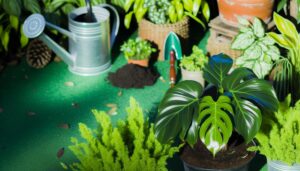Monstera Borsigiana Fertilizing Tips
To keep your Monstera Borsigiana healthy, use a balanced water-soluble fertilizer with equal parts nitrogen, phosphorus, and potassium (20-20-20). Feed every 4-6 weeks during the growing season, increasing to bi-weekly during peak growth.
Apply in the morning for best nutrient uptake. Avoid feeding in winter when the plant is dormant.
Regular soil testing helps determine deficiencies and prevents nutrient imbalances. Watch for signs of over-fertilization like leaf burn and yellowing.
Adjust feeding frequency based on growth rate and seasonal changes. The right techniques can ensure your plant remains vibrant and resilient; discover more below.

Key Takeaways
- Use a balanced water-soluble fertilizer with an N-P-K ratio of 20-20-20 during the active growing season.
- Avoid fertilizing in winter when Monstera Borsigiana is dormant to prevent root damage and nutrient imbalances.
- Apply fertilizers in the morning to maximize nutrient absorption through active stomatal activity.
- Monitor for signs of over-fertilization, such as leaf burn and stunted growth, and adjust feeding accordingly.
- Conduct regular soil tests to identify nutrient deficiencies and tailor your fertilization regimen for optimal plant health.
Understanding Nutrient Needs
To achieve the best growth for your Monstera Borsigiana, it's important to understand its specific nutrient requirements. This plant thrives with a balanced supply of macronutrients: nitrogen (N), phosphorus (P), and potassium (K).
Nitrogen supports lush foliage development, while phosphorus aids in root growth and flowering. Potassium is essential for overall plant health, enhancing disease resistance and water regulation. Trace elements like calcium, magnesium, and iron are also essential for maintaining vibrant leaf coloration and structural integrity.
Regular soil testing can help you determine nutrient deficiencies. By monitoring these critical nutrients, you can promote growth conditions, promoting a robust and healthy Monstera Borsigiana. Understanding these needs is the foundation for creating an effective fertilization regimen.
Best Fertilizer Types
Selecting the appropriate fertilizer for your Monstera Borsigiana guarantees it acquires the balanced nutrition necessary for optimal growth and health. Choose a well-rounded, water-soluble fertilizer with an N-P-K ratio of 20-20-20 or 10-10-10, which ensures consistent nutrient distribution.
Natural fertilizers, such as fish emulsion or worm castings, offer a slow-release nutrient profile. Furthermore, micronutrient-rich fertilizers, containing elements like iron, magnesium, and calcium, support overall plant well-being. Consider the following varieties:
- Balanced water-soluble fertilizers: Maintains equal proportions of nitrogen, phosphorus, and potassium.
- Natural fertilizers: Supply organic, slow-release nutrients.
- Micronutrient-rich fertilizers: Enhance essential trace elements.
- Controlled-release fertilizers: Provide gradual nutrient release over time.
- Liquid fertilizers: Ensuring rapid nutrient absorption for immediate requirements.
These choices encourage sturdy Monstera growth.
Timing Your Fertilization
Timing your fertilization schedule precisely is vital for ensuring your Monstera Borsigiana receives nutrients when it can most effectively use them. During the active growth phase, typically spring through early autumn, the plant's metabolic processes are accelerated, necessitating higher nutrient uptake.
Apply fertilizers in the morning when stomatal activity and root absorption rates are elevated. Avoid fertilizing in the winter months, as the plant enters a dormant state, and nutrient uptake is minimal. Ensuring soil moisture before application is pivotal to prevent root burn.
Utilize a balanced, water-soluble fertilizer to facilitate rapid nutrient availability and uptake. Monitoring environmental factors such as light, temperature, and humidity will also optimize fertilization timing, aligning nutrient application with the plant's physiological needs.
Frequency of Feeding
Maintaining an ideal feeding frequency for your Monstera Borsigiana is important to support its vigorous growth and overall health. You'll need to establish a consistent schedule to make sure your plant receives essential nutrients without over-fertilizing. Typically, feeding every 4-6 weeks during the active growing season is best. Adhering to this schedule can prevent nutrient deficiencies and promote robust foliage.
Here's a quick guide:
- Use a balanced, water-soluble fertilizer.
- Dilute the fertilizer to half the recommended strength.
- Apply fertilizer to moist soil to avoid root burn.
- Monitor the plant for signs of over-fertilization, such as yellowing leaves.
- Adjust the feeding frequency based on the plant's growth rate.
Seasonal Adjustments
Adapting your fertilization routine according to the changing seasons guarantees your Monstera Borsigiana receives essential nutrients for its varying metabolic needs throughout the year.
During the active growing season, typically spring and summer, increase the frequency of fertilization to bi-weekly, using a balanced, water-soluble fertilizer with an N-P-K ratio of 20-20-20. This supports vigorous leaf development and overall plant well-being.
In contrast, reduce feeding frequency to once every 6-8 weeks during fall and winter, when the plant's growth rate diminishes. Opt for a diluted solution to prevent nutrient buildup and root burn.
Monitoring your plant's response to these adjustments ensures prime health and growth, allowing it to thrive in its specific environmental conditions.
Organic Vs. Synthetic
Choosing between organic and synthetic fertilizers for your Monstera Borsigiana hinges on understanding their distinct compositions and impact on soil health and plant growth.
Organic fertilizers, derived from natural sources, enhance soil structure and microbial activity, ensuring long-term fertility.
Synthetic fertilizers, manufactured through chemical processes, provide immediate nutrient availability but may lead to soil degradation over time.
Key considerations include:
- Nutrient Release: Organic releases nutrients slowly, synthetic offers immediate results.
- Soil Health: Organic improves soil structure, synthetic can degrade it.
- Microbial Activity: Organic boosts beneficial microbes, synthetic may reduce them.
- Environmental Impact: Organic is eco-friendly, synthetic risks runoff pollution.
- Cost: Organic is often pricier initially, synthetic is generally cheaper.
Understanding these aspects helps you make informed fertilization choices.
Signs of Over-Fertilization
You might notice yellowing and wilting leaves as initial indicators of over-fertilization in your Monstera Borsigiana. Excessive fertilizer can also lead to salt buildup on the soil surface, which impedes nutrient uptake.
Monitoring these symptoms is vital to prevent long-term damage to the plant.
Yellowing and Wilting Leaves
When Monstera Borsigiana displays yellowing and wilting leaves, it's often a clear indication of over-fertilization, which disrupts the plant's nutrient balance and water uptake. Over-fertilization can cause an osmotic imbalance, drawing moisture away from the roots and leading to cellular dehydration in the foliage.
To address this, consider the following actions:
- Reduce Fertilizer Application: Cut back on the frequency and amount of fertilizer used.
- Leach the Soil: Thoroughly water the plant to flush out excess nutrients.
- Monitor Nutrient Levels: Regularly test the soil to ensure nutrient concentrations are within ideal ranges.
- Adjust Watering Practices: Guarantee the plant receives adequate, but not excessive, water.
- Inspect Root Health: Check for root damage or rot, which can worsen nutrient uptake issues.
Salt Buildup on Soil
Salt accumulation on the soil surface is a clear sign of excessive fertilization, resulting from the buildup of soluble salts that plants can't absorb efficiently. You'll often observe a white, crusty layer on the soil, which can lead to osmotic stress. This situation hinders the plant's capacity to take in water, causing dehydration and nutrient imbalances.
To address this issue, carry out a soil flush by thoroughly watering until excess salts drain out. Regularly monitor the electrical conductivity (EC) of the soil to keep soluble salts within ideal limits. Utilize balanced, slow-release fertilizers and avoid excessive application.
DIY Fertilizer Options
Crafting your own fertilizer for Monstera Borsigiana can greatly enhance its nutrient uptake and overall health, utilizing common household ingredients and scientific formulations. By creating a balanced nutrient mix, you can provide essential macronutrients and micronutrients without relying on commercial fertilizers.
Here are some effective DIY options:
- Banana Peel Tea: Soak banana peels in water for potassium enrichment.
- Eggshell Powder: Crush and blend eggshells for a calcium-rich additive.
- Coffee Grounds: Use spent coffee grounds to add nitrogen to the soil.
- Epsom Salt Solution: Dissolve Epsom salt in water to supply magnesium and sulfur.
- Compost Tea: Brew compost in water to create a nutrient-dense liquid.
These methods offer a sustainable approach to fertilizing your Monstera Borsigiana.
Common Fertilizing Mistakes
Over-fertilizing your Monstera Borsigiana can lead to nutrient burn, characterized by brown leaf tips and edges.
It's important to maintain correct nutrient ratios, as imbalances can cause deficiencies or toxicities, impacting plant health.
Make sure you follow recommended fertilizing schedules and formulations to avoid these common pitfalls.
Over-Fertilizing Your Monstera
One of the most common mistakes Monstera Borsigiana owners make is applying too much fertilizer, which can lead to nutrient imbalances and root damage.
Over-fertilization can cause a buildup of salts in the soil, leading to osmotic stress and impaired water uptake.
You should be watchful for signs of over-fertilization, such as:
- Leaf burn: Brown, crispy leaf edges.
- Stunted growth: Inhibited new leaf development.
- Yellowing leaves: Chlorosis due to nutrient lockout.
- Root damage: Blackened or mushy roots.
- Salt buildup: White crust on soil surface.
To prevent these issues, always follow recommended dosage guidelines and make sure proper watering to flush excess salts.
Regularly monitor your plant for any adverse symptoms and adjust your fertilization regimen accordingly.
Incorrect Nutrient Ratios
Incorrect nutrient proportions can disrupt the delicate equilibrium of essential minerals in your Monstera Borsigiana, leading to deficiencies or toxicities that impede the plant's growth and well-being. Over-supplying nitrogen can cause abundant foliage but weak stems, while phosphorus excess might inhibit micronutrient absorption like iron, resulting in chlorosis.
Inadequate potassium can decrease disease resistance and overall vigor. Ensure a balanced N-P-K (Nitrogen-Phosphorus-Potassium) ratio, typically 3-1-2 or 5-2-3, to meet the plant's specific requirements. Regular soil testing and using a complete, balanced fertilizer can help you avoid these pitfalls.
Adjust nutrient applications based on growth stage and environmental conditions for peak health. Monitoring your plant's response will guide you in fine-tuning your fertilization strategy.
Conclusion
Think of your Monstera borsigiana as a finely tuned instrument, needing the right strings of nutrients to play its symphony of growth. By mastering fertilization—balancing timing, type, and frequency—you guarantee a harmonious performance.
Avoiding over-fertilization's discord and understanding organic versus synthetic options fine-tunes this botanical orchestra. With expert care, your Monstera will thrive, its lush foliage a proof of your scientific precision and horticultural expertise.
Nurture it wisely, and watch it flourish into a verdant masterpiece.






